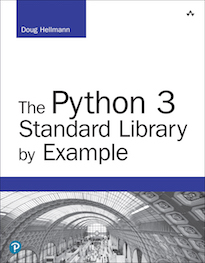deque — Double-Ended Queue¶
A double-ended queue, or deque, supports adding and removing
elements from either end of the queue. The more commonly used stacks and queues are
degenerate forms of deques, where the inputs and outputs are
restricted to a single end.
import collections
d = collections.deque('abcdefg')
print('Deque:', d)
print('Length:', len(d))
print('Left end:', d[0])
print('Right end:', d[-1])
d.remove('c')
print('remove(c):', d)
Since deques are a type of sequence container, they support some of
the same operations as list, such as examining the contents
with __getitem__(), determining length, and removing elements
from the middle of the queue by matching identity.
$ python3 collections_deque.py
Deque: deque(['a', 'b', 'c', 'd', 'e', 'f', 'g'])
Length: 7
Left end: a
Right end: g
remove(c): deque(['a', 'b', 'd', 'e', 'f', 'g'])
Populating¶
A deque can be populated from either end, termed “left” and “right” in the Python implementation.
import collections
# Add to the right
d1 = collections.deque()
d1.extend('abcdefg')
print('extend :', d1)
d1.append('h')
print('append :', d1)
# Add to the left
d2 = collections.deque()
d2.extendleft(range(6))
print('extendleft:', d2)
d2.appendleft(6)
print('appendleft:', d2)
The extendleft() function iterates over its input and performs
the equivalent of an appendleft() for each item. The end result
is that the deque contains the input sequence in reverse order.
$ python3 collections_deque_populating.py
extend : deque(['a', 'b', 'c', 'd', 'e', 'f', 'g'])
append : deque(['a', 'b', 'c', 'd', 'e', 'f', 'g', 'h'])
extendleft: deque([5, 4, 3, 2, 1, 0])
appendleft: deque([6, 5, 4, 3, 2, 1, 0])
Consuming¶
Similarly, the elements of the deque can be consumed from
both ends or either end, depending on the algorithm being applied.
import collections
print('From the right:')
d = collections.deque('abcdefg')
while True:
try:
print(d.pop(), end='')
except IndexError:
break
print()
print('\nFrom the left:')
d = collections.deque(range(6))
while True:
try:
print(d.popleft(), end='')
except IndexError:
break
print()
Use pop() to remove an item from the “right” end of the
deque and popleft() to take an item from the “left” end.
$ python3 collections_deque_consuming.py
From the right:
gfedcba
From the left:
012345
Since deques are thread-safe, the contents can even be consumed from both ends at the same time from separate threads.
import collections
import threading
import time
candle = collections.deque(range(5))
def burn(direction, nextSource):
while True:
try:
next = nextSource()
except IndexError:
break
else:
print('{:>8}: {}'.format(direction, next))
time.sleep(0.1)
print('{:>8} done'.format(direction))
return
left = threading.Thread(target=burn,
args=('Left', candle.popleft))
right = threading.Thread(target=burn,
args=('Right', candle.pop))
left.start()
right.start()
left.join()
right.join()
The threads in this example alternate between each end, removing items
until the deque is empty.
$ python3 collections_deque_both_ends.py
Left: 0
Right: 4
Right: 3
Left: 1
Right: 2
Left done
Right done
Rotating¶
Another useful aspect of the deque is the ability to rotate it in
either direction, so as to skip over some items.
import collections
d = collections.deque(range(10))
print('Normal :', d)
d = collections.deque(range(10))
d.rotate(2)
print('Right rotation:', d)
d = collections.deque(range(10))
d.rotate(-2)
print('Left rotation :', d)
Rotating the deque to the right (using a positive rotation)
takes items from the right end and moves them to the left
end. Rotating to the left (with a negative value) takes items from the
left end and moves them to the right end. It may help to visualize
the items in the deque as being engraved along the edge of a dial.
$ python3 collections_deque_rotate.py
Normal : deque([0, 1, 2, 3, 4, 5, 6, 7, 8, 9])
Right rotation: deque([8, 9, 0, 1, 2, 3, 4, 5, 6, 7])
Left rotation : deque([2, 3, 4, 5, 6, 7, 8, 9, 0, 1])
Constraining the Queue Size¶
A deque instance can be configured with a maximum length so
that it never grows beyond that size. When the queue reaches the
specified length, existing items are discarded as new items are
added. This behavior is useful for finding the last n items in a
stream of undetermined length.
import collections
import random
# Set the random seed so we see the same output each time
# the script is run.
random.seed(1)
d1 = collections.deque(maxlen=3)
d2 = collections.deque(maxlen=3)
for i in range(5):
n = random.randint(0, 100)
print('n =', n)
d1.append(n)
d2.appendleft(n)
print('D1:', d1)
print('D2:', d2)
The deque length is maintained regardless of which end the items are added to.
$ python3 collections_deque_maxlen.py
n = 17
D1: deque([17], maxlen=3)
D2: deque([17], maxlen=3)
n = 72
D1: deque([17, 72], maxlen=3)
D2: deque([72, 17], maxlen=3)
n = 97
D1: deque([17, 72, 97], maxlen=3)
D2: deque([97, 72, 17], maxlen=3)
n = 8
D1: deque([72, 97, 8], maxlen=3)
D2: deque([8, 97, 72], maxlen=3)
n = 32
D1: deque([97, 8, 32], maxlen=3)
D2: deque([32, 8, 97], maxlen=3)
See also
- Wikipedia: Deque – A discussion of the deque data structure.
- Deque Recipes – Examples of using deques in algorithms from the standard library documentation.
 PyMOTW-3
PyMOTW-3